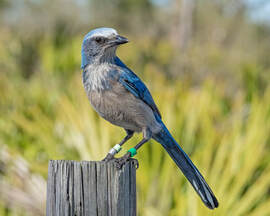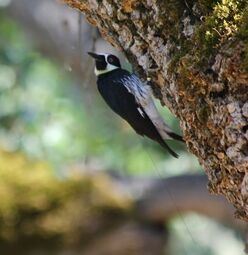|
Image: Jim Rodgers
|
BEHAVIOR
My research aims to understand the drivers that lead to the evolution of particular breeding strategies in organisms. I am currently working on several projects investigating fundamental questions about the evolution of cooperative breeding through the long-term research on Florida scrub-jays (top) at Archbold Biological Station in Florida, and acorn woodpeckers (bottom) at Hastings Natural History Reservation in California. |
Shizuka D., Barve S., Johnson A., Walters E. L. (2022). Constructing social networks from automated telemetry data: A worked example using within- and across-group associations in cooperatively breeding birds. Methods in Ecology and Evolution 13:133-143. Preprint available
Barve S., Riehl C., Walters E.L., Haydock J., Dugdale H.L., Koenig W.D. (2021). Lifetime reproductive benefits of cooperative polygamy vary for males and females in the acorn woodpecker (Melanerpes formicivorus). Proceedings of the Royal Society B: Biological Sciences 288: 20210579. Link
Barve S., Lahey A.S., Brunner R.M., Koenig W.D., Walters E.L., (2020), Woodpecker wars: Tracking warriors and spectators with telemetry. Current Biology 30: R982-983
Barve S., Hagemeyer N.D.G., Winter R. E., Chamberlain S.D., Koenig W. D., Winkler D. W., Walters E L. (2020) Wandering woodpeckers: foray behavior in a social bird. Ecology 101: e02943 Link
Koenig W. D., Walters E.L. Barve S. (2019) Does Helping- at-the-nest Help? The Case of the Acorn Woodpecker. Frontiers of Ecology and Evolution. Link
Barve S., Koenig W., Haydock J., Walters E. (2019). Habitat saturation results in joint-nesting female coalitions in a social bird. American Naturalist 193 830-840. Link
Barve S., Riehl C., Walters E.L., Haydock J., Dugdale H.L., Koenig W.D. (2021). Lifetime reproductive benefits of cooperative polygamy vary for males and females in the acorn woodpecker (Melanerpes formicivorus). Proceedings of the Royal Society B: Biological Sciences 288: 20210579. Link
Barve S., Lahey A.S., Brunner R.M., Koenig W.D., Walters E.L., (2020), Woodpecker wars: Tracking warriors and spectators with telemetry. Current Biology 30: R982-983
Barve S., Hagemeyer N.D.G., Winter R. E., Chamberlain S.D., Koenig W. D., Winkler D. W., Walters E L. (2020) Wandering woodpeckers: foray behavior in a social bird. Ecology 101: e02943 Link
Koenig W. D., Walters E.L. Barve S. (2019) Does Helping- at-the-nest Help? The Case of the Acorn Woodpecker. Frontiers of Ecology and Evolution. Link
Barve S., Koenig W., Haydock J., Walters E. (2019). Habitat saturation results in joint-nesting female coalitions in a social bird. American Naturalist 193 830-840. Link
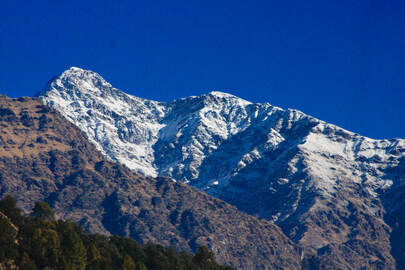
MOUNTAINS
Research on montane birds focuses on the mechanisms that drive the elevational distribution of species. I am especially interested in eco-physiology and the diverse adaptations birds have to cope with cold and hypoxic environments. Current research at the Smithsonian focuses on plumage adaptations in Himalayan birds.
Research on montane birds focuses on the mechanisms that drive the elevational distribution of species. I am especially interested in eco-physiology and the diverse adaptations birds have to cope with cold and hypoxic environments. Current research at the Smithsonian focuses on plumage adaptations in Himalayan birds.
PUBLICATIONS (selected)
Menon T., Ramesh V., Barve S. (2023). Himalayan birds that show the greatest elevational shifts remain within the narrowest thermal regimes. Global Ecology and Biogeography 32: 2111-2121.
Barve S., Daniel Cadena, C. (2022) Variation in insulative feather structure in songbirds replacing each other along a tropical elevation gradient. Ecology and Evolution 12: e8698. (Open access)
Barve S., Ramesh. V, Dotterer, T.M., Dove, C.D. (2021), Elevation, evolutionary origin, and body size drive variation in thermo-insulative feather structure of Himalayan birds. Ecography (Open access)
Ishtiaq F., Barve S. (2018). Do avian blood parasites influence hypoxia physiology in Himalayan birds? BMC Ecology 18:15. Link
Barve S., Dhondt A.A. (2017). Elevational replacement of two Himalayan titmice: interspecific competition or habitat preference? Journal of Avian Biology 48 (9) 1189-1194 * Chosen as cover article. Link
Ramesh V., Gopalkrishna T., Barve S., Melnick D. (2017). IUCN greatly underestimates threat levels of endemic birds in the Western Ghats. Biological Conservation 210 205-221. Link
Barve S., Dhondt A., Mathur V.B., Ishtiaq F., Cheviron Z. (2016). Life-history characteristics influence physiological strategies to cope with hypoxia in Himalayan birds. Proceedings of the Royal Society B: Biological Sciences 28320162201 Link.
*Dixit S., Joshi V., Barve S. (2016). Bird diversity of the Amrutganga Valley, Kedarnath, Uttarakhand, India with an emphasis on the elevational distribution of species. Checklist. Link
Menon T., Ramesh V., Barve S. (2023). Himalayan birds that show the greatest elevational shifts remain within the narrowest thermal regimes. Global Ecology and Biogeography 32: 2111-2121.
Barve S., Daniel Cadena, C. (2022) Variation in insulative feather structure in songbirds replacing each other along a tropical elevation gradient. Ecology and Evolution 12: e8698. (Open access)
Barve S., Ramesh. V, Dotterer, T.M., Dove, C.D. (2021), Elevation, evolutionary origin, and body size drive variation in thermo-insulative feather structure of Himalayan birds. Ecography (Open access)
Ishtiaq F., Barve S. (2018). Do avian blood parasites influence hypoxia physiology in Himalayan birds? BMC Ecology 18:15. Link
Barve S., Dhondt A.A. (2017). Elevational replacement of two Himalayan titmice: interspecific competition or habitat preference? Journal of Avian Biology 48 (9) 1189-1194 * Chosen as cover article. Link
Ramesh V., Gopalkrishna T., Barve S., Melnick D. (2017). IUCN greatly underestimates threat levels of endemic birds in the Western Ghats. Biological Conservation 210 205-221. Link
Barve S., Dhondt A., Mathur V.B., Ishtiaq F., Cheviron Z. (2016). Life-history characteristics influence physiological strategies to cope with hypoxia in Himalayan birds. Proceedings of the Royal Society B: Biological Sciences 28320162201 Link.
*Dixit S., Joshi V., Barve S. (2016). Bird diversity of the Amrutganga Valley, Kedarnath, Uttarakhand, India with an emphasis on the elevational distribution of species. Checklist. Link
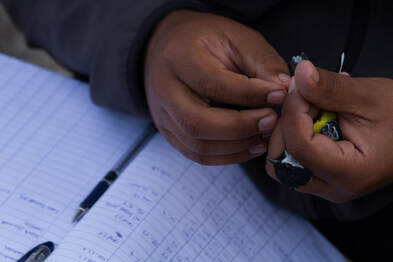
LIFE HISTORY
Independent colonization of similar habitats around the world have shaped behaviors and lead to convergent life histories. I am interested in exploring this intersection of environmental factors and behavior driving the diversity and distribution of particular life histories
Independent colonization of similar habitats around the world have shaped behaviors and lead to convergent life histories. I am interested in exploring this intersection of environmental factors and behavior driving the diversity and distribution of particular life histories
PUBLICATIONS (selected)
Barve S., Dhondt A., Mathur V.B., Ishtiaq F., Cheviron Z. (2016). Life-history characteristics influence physiological strategies to cope with hypoxia in Himalayan birds. Proceedings of the Royal Society B: Biological Sciences 2016 28320162201; DOI: 10.1098/rspb.2016.2201. Link.
Barve S., La Sorte F.A. (2016) Fruiting season length drives the global distribution of female-only parental care in frugivorous passerines. PLoS ONE 11(5): e0154871. doi:10.1371/journal.pone.0154871. Link
Barve S.*, Mason N.* (2015). Interspecific competition affects evolutionary links between cavity nesting, migration and clutch size in Old World Flycatchers. Ibis 157(2) 299-311. Link. (* Denotes equal contributions).
Barve S., Dhondt A., Mathur V.B., Ishtiaq F., Cheviron Z. (2016). Life-history characteristics influence physiological strategies to cope with hypoxia in Himalayan birds. Proceedings of the Royal Society B: Biological Sciences 2016 28320162201; DOI: 10.1098/rspb.2016.2201. Link.
Barve S., La Sorte F.A. (2016) Fruiting season length drives the global distribution of female-only parental care in frugivorous passerines. PLoS ONE 11(5): e0154871. doi:10.1371/journal.pone.0154871. Link
Barve S.*, Mason N.* (2015). Interspecific competition affects evolutionary links between cavity nesting, migration and clutch size in Old World Flycatchers. Ibis 157(2) 299-311. Link. (* Denotes equal contributions).
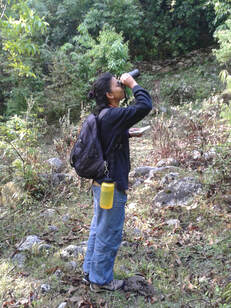
NATURAL HISTORY
Sound natural history is the backbone of ecological research, and in a rapidly changing world, it is critical to document natural history observations carefully. Natural history is also great way to get young ecologists excited and engaged in making systematic observations of the organisms that intrigue them and thinking more broadly about ecology and ecological processes.
PUBLICATIONS ( ** with mentees or led by mentees)
Dalvi S, Dixit D., Dharwadkar O., Thackeray T., Barve S., Khot R. (2021). The Sakhalin Leaf Warbler Phylloscopus borealoides: A new species for the Indian Subcontinent, and its status in the Andaman & Nicobar Islands. Indian Birds 17: 65-69 Link.
**Barve S., Lahey A.S., Brunner R.M., Koenig W.D., Walters E.L., (2020), Woodpecker wars: Tracking warriors and spectators with telemetry. Current Biology 30: R982-983
Barve S., Shankar Raman T. R., Jathar G., Datta A. (2020). Guidelines for conducting research on nesting biology of Indian birds. 16: 10-11. Link
Barve S., Shankar Raman T.R.S., Datta A., Jathar G. (2020). When and how to study the nesting biology of Indian birds: Research needs, ethical considerations and best practices. 16: 1-9. Link
**Crisologo T., Joshi V., Barve S. (2017). Jack of all calls and master of a few; vocal mimicry in the Tawny lark (Galerida deva). Avian Biology Research 10: 174-180. Link
**Barve S., Dixit S., Dhondt A.A., Ishtiaq F. (2017). Sexual dimorphism in breast stripe width and beak eco-morphology in Himalayan Green-backed Tits (Parus monticolus). Avian Biology Research 10: 259-263. Link
**Dixit S., Joshi V., Barve S. (2016). Bird diversity of the Amrutganga Valley, Kedarnath, Uttarakhand, India with an emphasis on the elevational distribution of species. Checklist 12: 1874. Link
**Muralidhar A. and Barve S. (2013). Peculiar choice of nesting site in Red wattled lapwing (Vanellus indicus) in an urban site. Indian Birds 8: 6-9. Link.
Sound natural history is the backbone of ecological research, and in a rapidly changing world, it is critical to document natural history observations carefully. Natural history is also great way to get young ecologists excited and engaged in making systematic observations of the organisms that intrigue them and thinking more broadly about ecology and ecological processes.
PUBLICATIONS ( ** with mentees or led by mentees)
Dalvi S, Dixit D., Dharwadkar O., Thackeray T., Barve S., Khot R. (2021). The Sakhalin Leaf Warbler Phylloscopus borealoides: A new species for the Indian Subcontinent, and its status in the Andaman & Nicobar Islands. Indian Birds 17: 65-69 Link.
**Barve S., Lahey A.S., Brunner R.M., Koenig W.D., Walters E.L., (2020), Woodpecker wars: Tracking warriors and spectators with telemetry. Current Biology 30: R982-983
Barve S., Shankar Raman T. R., Jathar G., Datta A. (2020). Guidelines for conducting research on nesting biology of Indian birds. 16: 10-11. Link
Barve S., Shankar Raman T.R.S., Datta A., Jathar G. (2020). When and how to study the nesting biology of Indian birds: Research needs, ethical considerations and best practices. 16: 1-9. Link
**Crisologo T., Joshi V., Barve S. (2017). Jack of all calls and master of a few; vocal mimicry in the Tawny lark (Galerida deva). Avian Biology Research 10: 174-180. Link
**Barve S., Dixit S., Dhondt A.A., Ishtiaq F. (2017). Sexual dimorphism in breast stripe width and beak eco-morphology in Himalayan Green-backed Tits (Parus monticolus). Avian Biology Research 10: 259-263. Link
**Dixit S., Joshi V., Barve S. (2016). Bird diversity of the Amrutganga Valley, Kedarnath, Uttarakhand, India with an emphasis on the elevational distribution of species. Checklist 12: 1874. Link
**Muralidhar A. and Barve S. (2013). Peculiar choice of nesting site in Red wattled lapwing (Vanellus indicus) in an urban site. Indian Birds 8: 6-9. Link.
